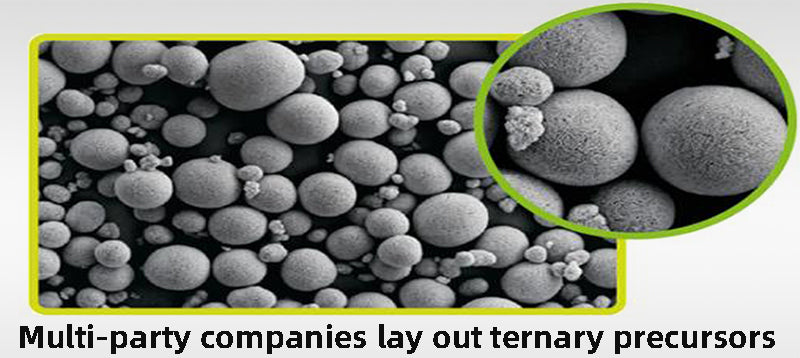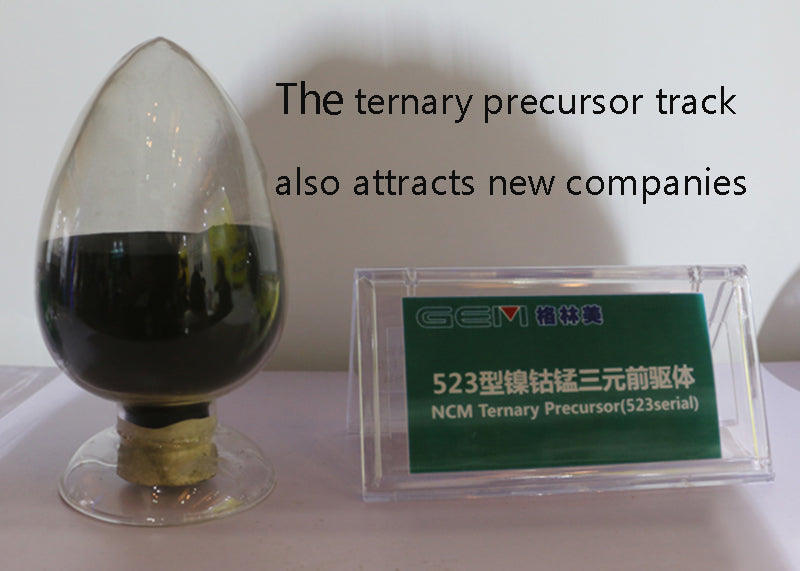
Main content:
As the cathode material with the largest cost in the ternary lithium battery, its upstream ternary precursor is the core raw material for making the ternary cathode material. It directly determines the key physical and chemical indicators of the ternary cathode material, and affects the core properties of the power battery such as energy density, rate performance, and cycle life. Driven by market demand such as the improvement of battery energy density, the value of ternary precursors has also continued to increase, and related companies have increased their layout.
1. Large orders for ternary precursors appear frequently
The downstream demand is strong, and there have been large supply orders for ternary precursors recently. Huayou Cobalt and CNGR successively announced that they had signed ternary precursor supply orders with Tesla respectively. Among them, CNGR orders are 3 years, Huayou Cobalt is 3 and a half years. Prior to this long order with Tesla, Huayou Cobalt has signed a long order for the supply of raw materials with REPT. It is expected that the two parties will purchase and sell a total of 800,000 tons to 1 million tons of terpolymer precursor and iron phosphate products between 2022 and 2030.
In addition, according to incomplete statistics, Huayou Cobalt has signed strategic cooperation agreements with Xtc, EASPRING, BTR and other enterprises, and is expected to lock supply orders for ternary precursors totaling more than 250,000 tons in the next three years. GEM has successively signed long-term supply agreements for ternary precursors and other materials with Xtc, South Korea's ECOPRO BM, Ronbay, EVE, Farasis and other companies. CNGR has signed ternary precursor supply agreements with EASPRING, Ronbay, Farasis and other companies. It is expected that the total supply of ternary precursors will exceed 500,000 tons in the next four years.

The long-term orders in the field of ternary precursors have successively landed, which proves the strong demand of downstream enterprises in the supply of ternary precursors, which is not only conducive to maintaining the stability of their raw material supply, but also reducing procurement costs. In terms of the market, relevant data show that from January to June 2022, the total output of ternary precursors in China was 359,000 tons, a year-on-year increase of 97%, and the average monthly output in the first half of the year was nearly 60,000 tons. Another agency predicts that the global demand for ternary precursors will reach 2.7 million tons in 2026, and the market size will reach 245.6 billion RMB. The market space is huge.
2. Multi-party companies lay out ternary precursors
The broad market prospect drives multi-party companies to deploy ternary precursor business, mainly including professional ternary precursor companies, upstream resource companies and downstream cathode material companies. Among them, companies specializing in the research and production of ternary precursors, such as Huayou Cobalt, Fangyuan New Materials Group, etc., generally have a long technology accumulation time and rapid product iteration, and have formed stable cooperative relations with some downstream customers. Companies with upstream metal resources such as nickel and cobalt extend their industrial chain downstream to ternary precursors, such as Huayou Cobalt, Tengyuan Building MATERIALS, GEM, etc.
The advantages of CNGR and Tengyuan Building MATERIALS lie in their holding of mineral rights, relevant metal smelting technology and resource production capacity, so they have the advantages of self-supply of resources and cost. GEM has the advantages of power battery recycling technology and material resources. In order to enhance market competitiveness, reduce procurement costs and ensure stable supply of raw materials, companies including EASPRING, Ronbay as one company of top 10 lithium battery ternary material companies, Xtc, Changyuan Lico and other leading ternary positive electrode materials have actively integrated upstream layout, self-built/co-built ternary precursor capacity, and increased the proportion of self-supplied raw materials.

Judging from their respective advantages, this move of upstream resource enterprises will help to give full play to their own resource advantages and expand new profit growth points. Cathode material companies are conducive to maintaining stable upstream supply and have more initiative in technology research and development. This also means that ternary precursor companies may form market competition with their upstream suppliers and downstream customers in the future. In addition to having the advantages of technology and old customers, the leading ternary precursor companies are also actively expanding their resource layout upstream to stabilize their own supply chains and enhance their market competitiveness.
3. The ternary precursor track also attracts new companies
Solid waste treatment company Weiming announced on August 4 that it plans to invest no more than 19.1 billion RMB in "cross-border" projects to build new materials for lithium batteries, including high-ice nickel refining, high-nickel ternary precursor production, high-nickel anode material production and related ancillary projects. While Weiming is outside the lithium sector, the project will be built by Weiming in a joint venture between CHENGTUN MINING, Tsingshan and Sunwoda, which is a different story. From the perspective of business cooperation, Weiming is mainly responsible for financing and has been involved in the production of high nickel matte. CHENGTUN MINING and Tsingshan provide technical support in metal resource utilization.
Sunwoda will provide support for product research and development and trial production, and promise to give priority to purchasing high-nickel ternary cathode material products from the joint venture under the condition of meeting the same quality and market price. The joint venture model not only reflects the integration of upstream and downstream of the industrial chain, but also runs through the ultra-long integrated layout of "metal resources - metal smelting - ternary precursor - ternary cathode - product application". It is worth noting that, as a key link, the production process of ternary precursors is delicate and complex, and the control of specific parameters has become the core barrier of its preparation technology. Coupled with the iterative upgrade of ternary cathode materials, the technical requirements for ternary precursors have been further improved, making the technical barriers in this field continue to rise.
The barrier of ternary precursor industry lies in that enterprises often need to customize ternary precursor according to the performance requirements of downstream customers' lithium batteries, and the process parameters of ternary precursor products are differentiated, so it is difficult for new entrants to break through the key process technologies in the short term. In this regard, Weiming also admits that there are challenges in the layout. There are certain market, technology and management risks in the production of three-way cathode materials, such as the supply of nickel-lithium cobalt and other raw materials, production technology and cost control, and downstream customer certification and binding, and there are certain capital, talent and technical barriers in the implementation of the project.

At present, the pricing of ternary precursors adopts the pricing model of metal price + processing fee, and the processing fee is determined according to the difference in processing difficulty and technical barriers. Companies involved in the ternary precursor business are expected to increase processing fee income and improve profitability. At the same time, the emergence of the trend of industrial chain integration is conducive to accelerating the iterative upgrade of ternary lithium battery cathode materials, or will stir up the industry pattern.
Related article: lithium ion battery cathode materials, top 10 lithium iron phosphate materials companies, top 10 lithium ion battery anode material companies in China